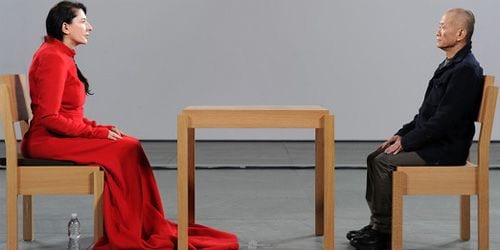
“When you perform it is a knife and your blood, when you act it is a fake knife and ketchup.”
— Marina Abramović
In the spring of 2010 the Museum of Modern Art held what was, until now, their largest exhibition of performance art; a retrospective of Marina Abramović’s work entitled “The Artist is Present”. The exhibition included recreations of the Serbian artist’s most famous works, all of which supported the main performance; one in which the artist sat immobile in the museum’s atrium, while spectators took turns sitting in front of her. The performance ran for a total of 736 hours.
In preparation for this performance, the artist expresses how nobody has asked the most important question about it: “Why is this art?” Her collaborators and assistants seem flabbergasted someone, and Marina in particular, would come up with such a blasphemous remark. Yet it is in this challenging question where the entire essence of her work is comprised.
Marina Abramović: The Artist is Present is a brilliant documentary that goes beyond biographic conventions and explores the notion of how art is created, consumed and digested in our times. Director Matthew Akers (who also served as cinematographer) takes us into the world of one the most enigmatic figures in modern art, without ever allowing the artist’s overwhelming presence to prevent him from delivering his own artistic ideas.
Akers uses Abramović as a vessel through which he can question the world of art and its idiosyncrasies, including the notion that non-commercial artists, too, can command armies of admirers which can be likened to groupies. Watching how people lined up to see the MoMA exhibit — even creating unofficial numbering systems — brings up fascinating questions to viewers, including how people united for a cause feel the urge to create microscopic government units or how unemployment led people to have more free time and in a way find a spiritual connection with this exhibition.
Likewise, these pro-artistic ideas create a dichotomy when juxtaposed with a necessary negative reflection. For every person who believes they’re creating art by sitting outside waiting to see the artist, there’s more who don’t care, don’t believe this is art, or even link this empowering of alternative work to the economic crisis. Shouldn’t these people be working or trying to find work instead of attending this exhibition 21 times like one audience member reveals? Akers is clever enough a filmmaker to observe without passing any judgment whatsoever.
He focuses on showing us who Marina Abramović is, without deifying or demonizing her. The film takes a look at Abramović’s entire career, beginning with her family life in Belgrade where the artist herself narrates how she grew up in a complex household, with her parents being dedicated Partisans and her grandmother exercising religion and tough love. She suggests that this defined who she became as a creator, while people close to her reveal that her need for love might be what tempted her to get close to people, to seek the adoration she never got as a child.
However, this never becomes facile psychology, particularly when Marina’s former lover/collaborator Ulay Laysiepen enters the picture. We see their first meeting in years, only to be left strangely unmoved. Ulay, always looking like the uncompromised pragmatic reveals how even if he looks like a workman, it is Marina who’s the non-stopping worker. We come to understand that their relationship defined both their careers but we also see how Marina allowed her emotions to rule over her, while Ulay remained a pure aesthetician.
One might think that their unorthodox love story might be difficult to connect to, yet halfway through the film they share a moment that will undoubtedly bring tears to some viewers, challenging even those who think Marina is a poser. This unexpected connection to a message created by someone so distant to us has unexpected repercussions that defy our expectations. Isn’t this, after all, what art is supposed to be all about?
Music Box Films and HBO Documentary Films have put together an exceptional DVD release for this documentary. Bonus features include almost a full hour of new material including looks at how the audience “completes” the artist’s work, a fascinating featurette about a young artist obsessed with becoming like Marina and an unexpectedly informative look at the costumes worn by the artist during the groundbreaking exhibition. You see how there is absolutely no spontaneity behind the preparations for her work, particularly with how the costume designer reveals she wanted her to look both regal and saintly. A moving piece called Belgrade Homecoming shows Marina with an older relative who stirs emotions in her when she talks about her mother and grandmother.
Marina Abramović: The Artist is Present is a must-see documentary, whether you’re into modern art or not. It will surprise you in endless ways.
